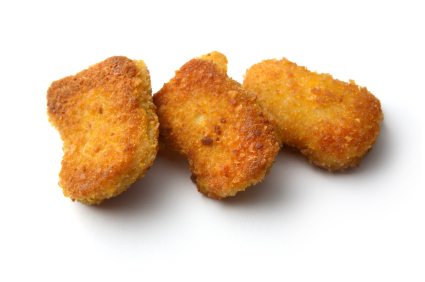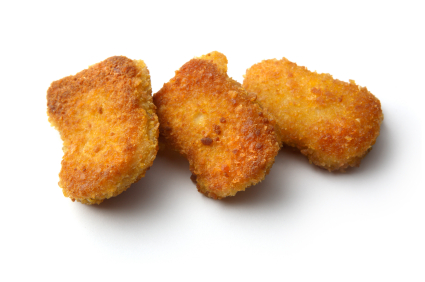When my info-larder gets too packed, it’s time to serve up some choice nuggets from around the Web.
 Get’em while they’re hot.
Get’em while they’re hot.
Raw egg deal
Confession: I regularly whip raw egg yolks from our free-running hens into aioli. I’m not saying you should follow my example, but no one ever gets sick when I do it. In the weeks since the massive industrial-egg recall, I’ve done it no fewer than three times. Am I nuts?
Fellow food-politics writer and micro-scale chick magnate Barry Estabrook also had questions about the products of his backyard flock. In a recent post, he tells of having his home eggs tested for salmonella in a lab. Results: negative. Barry goes on to speculate why free-scratching hens might be less prone to producing salmonella-tainted eggs than their imprisoned sisters. John L. Ingraham, emeritus professor of microbiology at the University of California Davis, gives him a great quote:
I don’t think there is any doubt about it that healthy chickens living in decent surroundings are just going to be a lot more resistant to salmonella … Take any creature, ourselves included, you put them in a terrible stressful conditions and they become susceptible to disease.
This line of questioning is precisely what’s missing from the current discussion of the recall. While people like me obsess over the corporate machinations behind the disaster, and the FDA focuses on making an inherently sick system marginally less hazardous, few — and no one in power, from what I can tell — question the production model that makes such outbreaks inevitable.
Related: Students of industrial agriculture and the the egg recall won’t want to miss Joe Fassler’s exhaustive timeline of Jack DeCoster’s various violations on the Atlantic website; or William Neuman’s excellent Times piece tying DeCoster egg operations to large salmonella outbreaks dating to 1987.
David Kirby, who covers factory farms for Huffington Post, raises an interesting point: If the food-safety authorities recall eggs when they’re tainted with salmonella and beef when it’s tainted with E. coli 0157, why do they wave through pork when it’s tainted with MRSA, the antibiotic-resistant staph bacteria? Writes Kirby: “Now MRSA is showing up in random samples of raw pork sold in supermarkets, and to a lesser extent in beef and chicken. Yet these potentially deadly cuts of meat — unlike the salmonella-tainted eggs — have never been yanked off the shelves.”
Reefer sadness
Coral reefs are engines of biodiversity. According to a 2007 paper from the Duke Environmental Law and Policy Forum, they occupy less than 1 percent of the ocean floor, but house as many as a quarter of the globe’s sea species. They are under intense pressure from climate change, among other human-induced threats including overfishing and pollution. Unhappily, the hot summer of 2010 could spark a coral cataclysm, The New York Times reports: “This year’s extreme heat is putting the” world’s coral reefs under such severe stress that scientists fear widespread die-offs, endangering not only the richest ecosystems in the ocean but also fisheries that feed millions of people.”
Unhappy cows still make milk
In his enthusiastic but confused recent apology for industrial agriculture — which I discussed here — the U.K. food writer Jay Rayner observes that “Unhappy, ill animals do not produce milk, so it’s not in the [factory-scale] farm’s interests to mistreat them or shorten their lifespan.” Unfortunately, he’s wrong about that. Jacked up with hormones, antibiotics, and feed additives, abused animals can be compelled to produce at high levels. Jack DeCoster’s infamous hen houses are notorious for wretched conditions, yet they produce more eggs than any other magnate’s flock. And now the U.K.-based Ecologist Magazine has managed to finagle its way into a vast California dairy operation, aided by “disgruntled dairy employees.” Sample from the exposé:
It is a continual daily cycle that stops only when the milk output begins to tail off, and the animals are either re-impregnated or sent off to slaughter; burnt out and discarded after only a few years of life on the factory floor. Animals in American mega dairies will never see a patch of grass in their life, and the only respite comes from shade in the dusty open-air lots where they wait between milking. Even here the animals will not get a chance to really rest; high-milk yielding cows suffer from chronic ‘negative energy balance’, where the cow uses more energy in making milk that she can physically take in by eating, losing body condition as a result.
Other hot stuff
On an altogether less wonky and happier front, why do some people, including me, adore the sting of chile peppers? Homo sapiens is the only species on earth known to eat them. What gives? According to a developing theory, it’s because they hurt so good.
BPA, the nasty substance ubiquitous in consumer plastics, ends up in our bodies at rates “much higher than previously assumed,” a new study concludes. Now will the FDA follow the lead of its Canadian counterpart and declare it toxic?
Pure foodie-ism, 1: The wonderful wine and food writer Eric Asimov ruminates on his boredom with ultra-fancy food and prestige wine, before revelling in both at a 38-course dinner at El Bulli.
Pure foodie-ism, 2: Randall Grahm of California’s Bonny Doon Vineyard is one of the leading U.S. proponents of natural wine. (What’s that, you ask? Read this.) He’s also a hilarious character
— a man of infinite jest — and a really good writer. And now, in the space attached to the Santa Cruz warehouse where he makes his wine, Grahm has hired an ambitious, pedigreed young chef to run a restaurant. Apparently, the venerable wine maker has some rather unorthodox ideas about what “communal dining” means.


